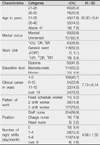Abstract
Purpose
This study was done to identify the relationship of occupational stress, emotional labor, and general characteristics to somatization, and to identify factors affecting somatization in nurses.
Methods
A quantitative, descriptive research design was used to study 227 nurses. Nurses completed a 52-item self-questionnaire that included 3 concepts assessing somatization, occupational stress, emotional labor. The collected data were analyzed using descriptive statistics, t-test, ANOVA, Pearson correlation coefficients and multiple regression.
Results
Mean scales for somatization, occupational stress, and emotional labor were 22.96±7.87, 78.73±12.29, 29.63±3.97 respectively. The explained variance for somatization was 35.5%. Among the variables, frequency of emotional display (β=.136, p=.042), one of the sub-domains of emotional labor, and role overload (β=.178, p=.023), one of the sub-domains of occupational stress and working in the ICU, OR, or ER (β=.296, p<.001) and education level of diploma graduation (β=.143, p=.028) significantly predicted degree of somatization.
Figures and Tables
References
1. Abraham R. The impact of emotional dissonance on organizational commitment and intention to turnover. J Psychol. 1999. 133(4):441–455.

2. Ahn MK. The effect of nurse's job stress on health practice behavior. 2003. Seoul: Yonsei University;Unpublished master's thesis.
3. Baines C, Evans P, Neysmith S. Women' caring: Feminist perspectives on social welfare. 1991. Toronto: McClelland & Stewart.
4. Bakker AB, Heuven E. Emotional dissonance, burnout, and in-role performance among nurses and police officers. Int J Stress Manag. 2006. 13(4):423–440.

5. Begat I, Ellefsen B, Severinsson E. Nurses' satisfaction with their work environment and the outcomes of clinical nursing supervision on nurses experiences of well-being. J Nurs Manag. 2005. 13(3):221–230.

6. Bolton S. Change faces: nurses as emotional jugglers. Sociol Health Illn. 2001. 23(1):85–100.
7. Choi JS. The impact of the hotel internal marketing on emotional labor and service level of employees. Conv Res. 2004. 7:165–188.
8. Erdfelder E, Faul F, Buchner A. GPOWER: A general power analysis program. Behav Res Methods Instrum Comput. 1996. 28(1):1–11.

9. Humpel N, Caputi P. Exploring the relationship between work stress, years of experience and emotional competency using a sample of Australian mental health nurses. J Psychiatr Ment Health Nurs. 2001. 8(5):399–403.

10. Joung MS, Kim KJ. A study on the effect of emotional Labor and Leader's emotional intelligence on job satisfaction and organizational commitment for nurses. Korean J Hosp Manage. 2006. 11(4):1–18.
11. Jung YH, Yoo KH, Lee YS. Work characteristics and psychosomatic symptoms in industrial workers. Chungnam Med J. 1994. 21(1):93–101.
12. Kang HA. Changes in nursing professional work - change of emotional labor. Econ Soc. 2002. 55:142–168.
13. Koo MH. The employment structure and labor control of female contingent workers in Korea: A case study of females workers in the department store industry. 2002. Daejeon: Chungnam University;Unpublished doctoral dissertation.
14. Lee BL, Kim DJ, Shin MS, Choi BM. A preliminary study on the standardization of the Korean versions of Wahler physical symptom inventory. J Korean Neuropsychiatr Assoc. 2002. 41(1):146–158.
15. Lee D, Kim JH. Effect of job stress on psychiatric symptoms-focused on gender difference of medication effect of self-esteem. J Korean Neuropsychiatr Assoc. 2001. 40(2):217–229.
16. Lee JI, Min KH. The Effects of Emotional Labour upon Felt-emotions, Expressed-emotions, and Their Discrepancies. Korean J Soc Psychol. 1999. 13(2):149–171.
17. Moracco JC, McFadden H. The Counselor's role in reducing teacher stress. Pers Guid J. 1997. 60(9):549–552.

18. Morris JA, Feldman DC. The dimension, antecedents and consequences of emotional labor. Acad Manage Rev. 1996. 21(4):986–1010.
19. Oh HJ. The impact of job stress and alexithymia on somatization. 2008. Daegu: Daegu University;Unpublished master's thesis.
20. Olesen V, Bone D. Gillian , Simon J, editors. "Emotions in rationalizing organizations: conceptual notes from professional nursing in the USA" in Bendelow. Emotions in Social life: Critical themes and contemporary issues. 1998. London: Routledge.
21. Park JW, Kim JH. The effect of occupational stress, self esteem and perfectionism on anxiety and somatization symptom. Korean J Clin Psychol. 2001. 20(4):697–710.
22. Ring A, Dowrick CF, Humphris GM, Davies J, Salmon P. The somatizing effect of clinical consultation: what patients and doctors say and do not say when patients present medically unexplained physical symptoms. Soc Sci Med. 2005. 61(7):1505–1515.

23. Sakong J, Chung JH, Kim HS. The effects of job on Psychosomatic strain and gastrointestinal symptom. Korean J Occup Environ Med. 1997. 9(3):530–542.

24. Shin HK. The effects of negative affectivity, alexithymia, somato-sensory amplification, and somatic attribution on somatization: test of a linear mediation model. Korean J Clin Psychol. 2000. 19(1):17–32.
25. Stanley IM, Peters S, Salmon P. A primary care perspective on prevailing assumptions about persistent medically unexplained physical symptoms. Int J Psychiatry Med. 2002. 32(2):125–140.

26. The Institute of Korean Nurses Association. Statistical Yearbook of Nursing 2007. 2007. Retrieved from http://www.koreannurse.or.kr.
27. The National Swedish Board of Health and Welfare. The Swedish Public Health Report. 2001. Stockholm, Sweden: Modin-Tryck.
28. Vitello-Cicciu JM. Emotional intelligence. Nurs Manage. 2003. 10. 34:28–32.
29. van der Weijden T, van Velsen M, Dinant GJ, van Hasselt CM, Grol R. Unexplained complaints in general practice: prevalence, patients' 'expectations, and professionals' test-ordering behavior. Med Decis Making. 2003. 23(3):226–231.

30. Yoon SH. The effects of organizational managerial characteristics and job characteristics on job stress and job effectiveness: A survey on clinical nurses. Korean J Ind Organ Psychol. 2004. 17(3):451–466.




 PDF
PDF ePub
ePub Citation
Citation Print
Print







 XML Download
XML Download